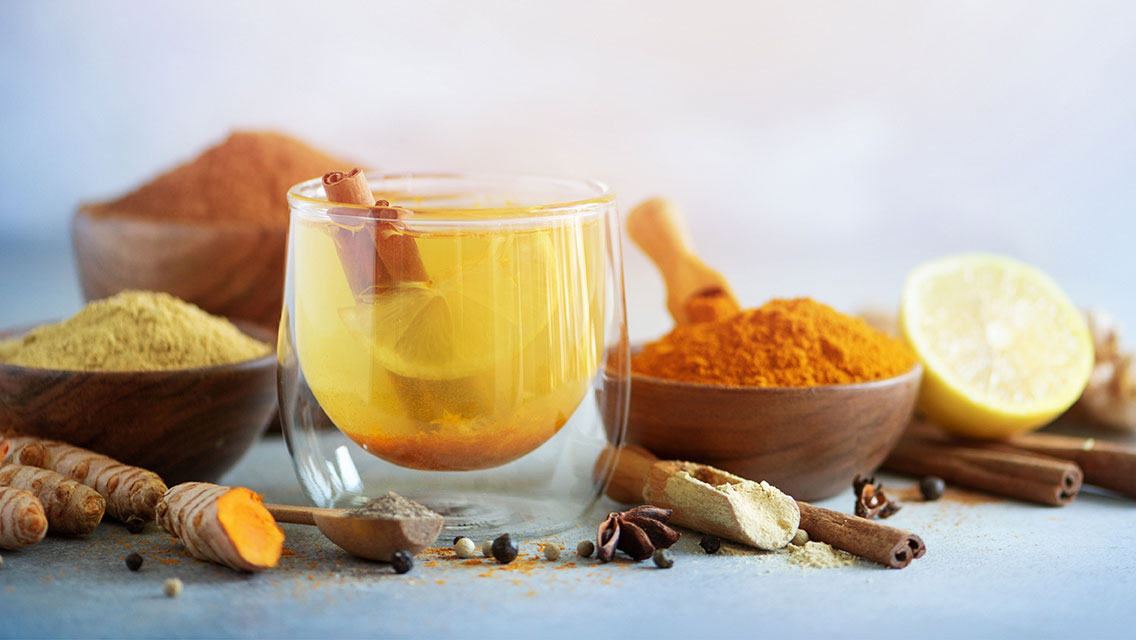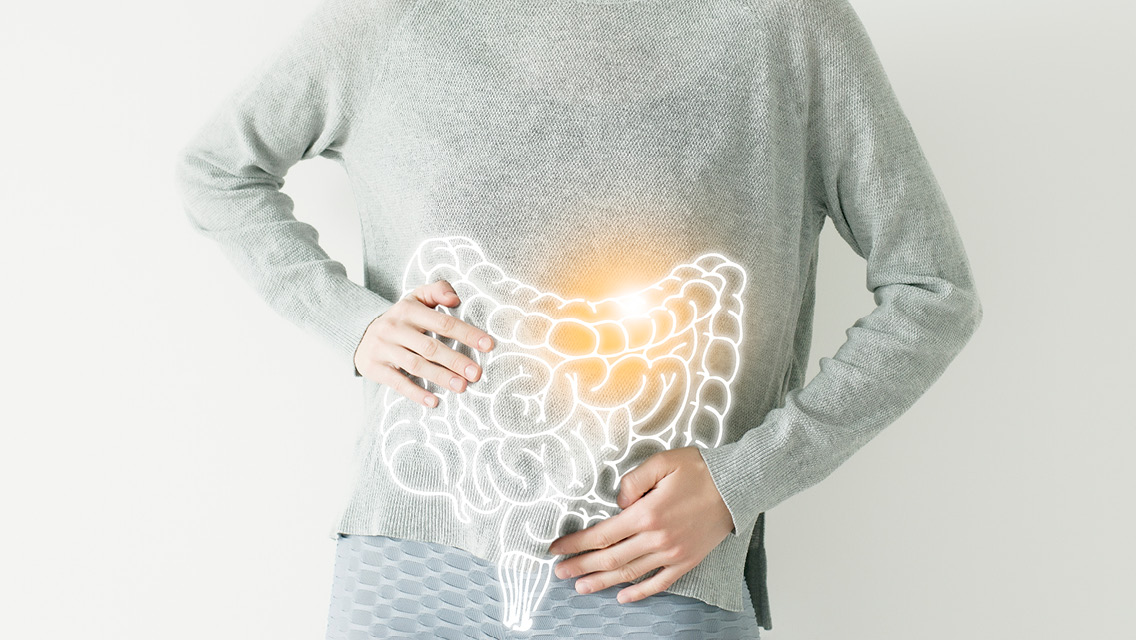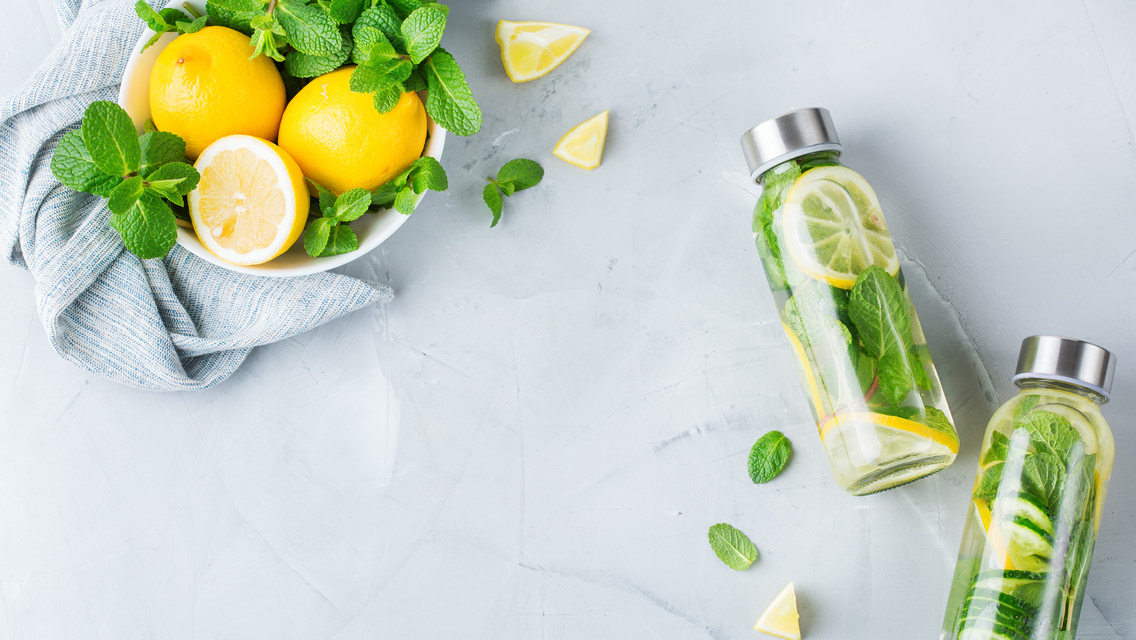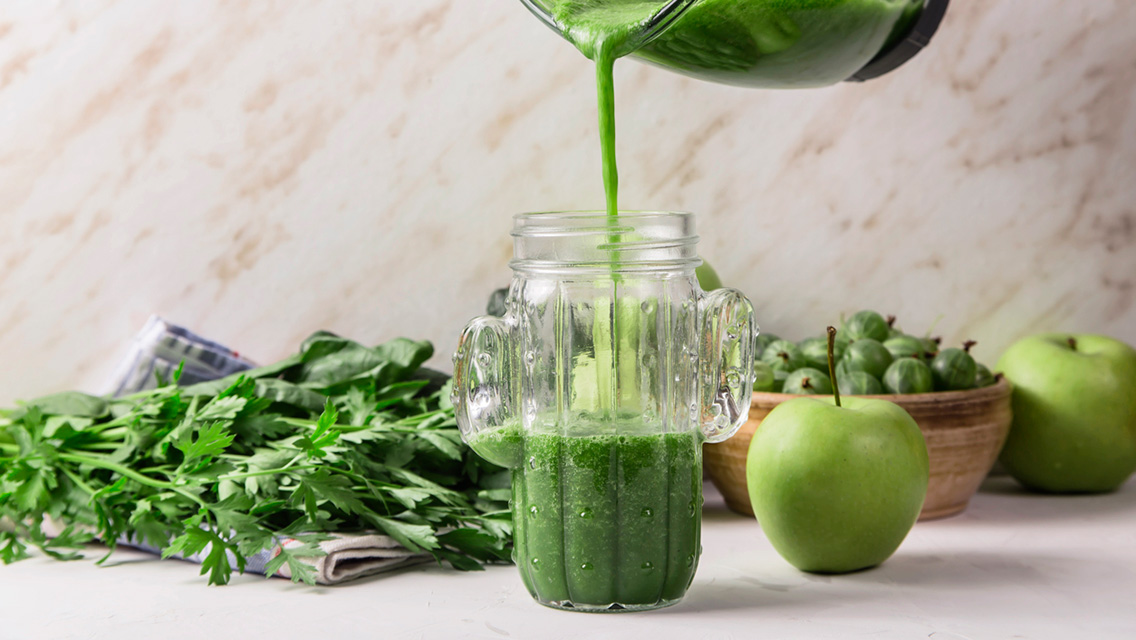Learn more about your body’s detox systems:
The GI System ⋅ The Liver ⋅ The Kidneys ⋅ The Skin ⋅ The Lungs
Our bodies are natural masters of detoxification. The liver, gut, and kidneys are constantly sorting helpful from harmful molecules. Toxins that would otherwise make us ill are ushered out of the body through urine, stool, mucus, and (according to some practitioners) sweat. Meanwhile, the essential building blocks of life — think oxygen and protein — are shuttled to the cells that need them.
In ideal circumstances, this elegant system hums along with no need for intervention. So, what’s up with all the diets, products, and protocols claiming to help the body detox? Do we really need them?
Usually not, says Sara Jean Barrett, ND, a Minneapolis-based integrative practitioner who treats patients with chronic health conditions. “Detoxification is a physiological process that the body carries out all the time. There’s not a lot of complicated things you need to add to enable it.” She notes that many detox protocols contain laxatives, which can create problems of their own by disrupting the microbiome.
Most integrative practitioners will recommend structured, supervised detox programs to address stubborn issues, but these protocols are not the only option. There are also daily actions one can take to support the body’s natural detoxification strategies. And as we encounter greater quantities of pollution, it’s important to do so. “We’re being exposed to so much more than we ever have been before,” Barrett notes.
On an ordinary day, we might encounter industrial contaminants, like heavy metals and phthalates; agricultural toxins, such as pesticides; household toxins from rugs, paint, and cleaning supplies; toxic additives in personal-care products and cosmetics; and artificial flavors, sweeteners, and food coloring. All these add up to a hefty workload for our detoxification organs to process.
What’s more, these external toxins are crowding in with the natural waste products our bodies produce on their own. “The body’s detox system takes care of our hormones and all the metabolites of being alive; it breaks protein down into nitrogen,” Barrett says. “Environmental exposures and things like medications or alcohol just add on top of that.”
In Ayurveda, the traditional medical approach originating in India, the residue of toxins in the body is known as “ama.” This buildup occurs when the body’s capacity to metabolize toxins is impaired or weak.
“The word ‘ama’ means partially digested,” explains Bhaswati Bhattacharya, MPH, MD, PhD, a board-certified and licensed physician with advanced training in pharmacology and Ayurveda who practices integrative medicine in New York City. “The body usually sends what it can’t digest out as a waste product in poop, urine, breath, or sweat. But ama, or undigested products that can become toxins, are those residues that build up in the body and prevent you from having an easy flow in life.”
She likens toxic ama buildup to a hoarder’s home. If a person buys dozens of rolls of paper towels and stashes them in the garage — and then buys dozens more — the whole mess, along with other unused junk, starts to rot and mold, and the space ceases to be a functioning garage.
“It’s become polluted to the point where you can’t sort through it. That’s what can happen in the body. Items that were OK in the beginning sit there and rot or interact with another substance and transmute into something that’s no longer benign,” Bhattacharya says. “Disease begins.”
This process is what functional-medicine practitioners refer to as our toxic load, or body burden — toxins that exceed the body’s capacity to eliminate them and end up stored in our tissues, blood, and bones.
“When the toxic load increases past a certain point, detoxing gets harder,” notes Institute for Functional Medicine board chair Joseph Pizzorno, ND, in his book The Toxin Solution.
Differing Detox Capacities
Several factors affect your individual toxic load. The first is exposure. “Everyone has a different exposure level to things in our environment,” Barrett says.
She notes that particular occupations, or living near industrial sites, may expose us to more toxins than our body’s natural detox systems can handle. This is a risk for, among others, agricultural workers, cleaners, nail technicians, hairdressers, miners, and people who work in certain types of manufacturing — all have higher-than-average exposure to toxic chemicals.
Genes also play a critical role. “Genes dictate our individual ability to detoxify everything from drugs to chemicals to hormones,” Barrett adds.
For example, a gene known as MTHFR (methylenetetrahydrofolate reductase) produces an enzyme to support methylation, a cellular process essential for detoxification. Between 30 and 40 percent of people carry variants of the MTHFR gene that correspond to slower methylation, which compromises their body’s ability to eliminate toxins. (For more, see “What Are SNPs and Why Do They Matter?”)
Genetics help explain why two people might react very differently to the same exposure. “Some people are more susceptible to damage to their immune system, so they will have more allergies and autoimmune problems,” notes Pizzorno. “For others, their mitochondria might be more susceptible to toxins, so they will become more fatigued.”
Nutritional status matters too. “Vitamins and minerals act as cofactors for most of our detox pathways, so without adequate nutrition, it can be challenging to detoxify effectively,” Barrett explains.
Meet the Detox System
Integrative- and functional-medicine physicians have long emphasized the importance of reducing toxic exposures and supporting the body’s detoxification systems. Get to know those systems, plus how they work and how to know when they need a helping hand.
The GI System
The gastrointestinal tract is where we ingest and process everything we eat. It’s also the primary garbage chute for toxins; it partners with the liver to bind and flush them out through the stool. “The No. 1 way to support detoxification, outside of avoiding exposures, is with regular bowel movements,” Barrett says.
Fiber is crucial here — particularly the soluble type found in legumes, vegetables, fruit, nuts, and seeds. Not only does fiber help prevent constipation, but it binds to toxins, cholesterol, and waste products and prevents them from being reabsorbed by the body. “If you’re not having at least one well-formed bowel movement per day, you’re having some reabsorption happening, and your poor liver is having to deal with things twice or more,” says Barrett.
Fiber also feeds our beneficial gut flora. These microbes help break down fiber into beneficial compounds and produce short-chain fatty acids that support the intestinal lining. A healthy gut lining is crucial for nutrient absorption; it also acts as a barrier against harmful substances. When the gut is leaky, these substances can leach into the bloodstream and increase our toxic load.
Some gut bacteria are even involved in detoxification directly. “Certain strains of Lactobacillus bacteria prevent the tag on estrogen [that marks it for elimination] from being removed,” Barrett explains. “If those strains aren’t around, that tag can get cleaved, estrogen gets reabsorbed, and the liver has to process it all over again.”
Signs of GI trouble might include constipation, diarrhea, gas, bloating, or cramps. Systemic issues, such as inflammation, autoimmunity, joint pain, skin problems, migraine, and fatigue, can also be indicators of leaky gut, an imbalanced microbiome, and likely a toxic overload.
How to Support the GI System:
Daily habits to support gut health include eating a whole-foods, fiber-rich diet; taking a quality probiotic supplement; eating fermented foods like kefir and sauerkraut; minimizing processed foods; managing stress; and exercising. When things are significantly out of balance, working with a functional nutritionist or doctor on a more rigorous gut-healing protocol may be in order.
The Liver
The liver plays a central role in detoxifying the body. This organ engages in a two-step process, filtering the blood and removing and neutralizing harmful substances.
These steps are often described as phase 1 and phase 2 detoxification. During phase 1, the liver releases enzymes that turn fat-soluble toxins into “intermediate” metabolites. Notably, these compounds can be more reactive or harmful than the original toxins.
During phase 2, the liver continues to process these intermediate compounds, making them water soluble so they can be sent to the gut (in bile) to exit the body in the feces, or to the kidneys (in blood) so they can be ushered out in the urine.
For the body to detoxify properly, both phases need to function optimally. If the first phase is overactive and the second sluggish, those reactive intermediate metabolites can accumulate and do damage.
One toxin that exploits an imbalance in this system is polycyclic aromatic hydrocarbon (PAH). Found in tobacco smoke, charred foods, and environmental pollutants, PAHs are converted during phase 1 into dangerous compounds called reactive epoxides. If those epoxides aren’t fully neutralized in phase 2, they can bind to DNA and lead to cancer-causing mutations.
This is why Barrett recommends caution with detox protocols, which don’t always support both phases.
“I sometimes see formulas that try to push a faster phase 1 without addressing phase 2,” she says. “When supporting detoxification, you want to work backward from the last step.”
Barrett emphasizes that the correct order for detox protocols begins with ensuring regular elimination, then supporting phase 2 liver detoxification. After you’ve attended to those, supporting phase 1 detoxification is appropriate.
Signs of liver congestion include fatigue, pale stools, itchy skin, and hormone imbalances. All are good reasons to work with a provider to safely support the liver in detoxing.
Meanwhile, a yellowish tint to the skin and eyes and sensations of pain and fullness around the liver (which sits in the upper-right side of the abdomen) are signs of severe liver toxicity, which requires immediate medical attention.
How to Support the Liver:
One easy way to support both phases of detoxification is to eat cruciferous vegetables, such as kale, broccoli, cauliflower, radishes, and Brussels sprouts. These members of the Brassicaceae family contain indole-3-carbinol and sulforaphane, compounds that help the liver produce phase 1 enzymes. Sulforaphane also helps create glutathione, which binds to toxins in phase 2 to make them water soluble.
Bitter plants like dandelion greens, artichokes, and turmeric are also detox powerhouses, supporting the flow of bile and reducing liver congestion. And it’s no coincidence that some of these plants are in peak season in the spring and fall, says Bhattacharya. “I tell people that when the weather changes from cold to hot or hot to cold, that’s the time to do a liver cleanse. Many bitter plants pop up right at that time.”
The Kidneys
Ever noticed your urine turning neon yellow after taking a multivitamin? If so, you’ve witnessed your kidneys at work. Vitamin B2 (riboflavin) is a yellow, water-soluble vitamin; when the body absorbs what it needs, the kidneys ensure that the excess is excreted through the urine. Hence the dramatic color change.
This small pair of bean-shaped organs filters all your blood dozens of times per day. In addition to surplus vitamins, the kidneys clear out ammonia, urea, uric acid, creatinine, heavy metals, hormone metabolites, and excess salt.
Though the kidneys regularly remove these substances from the blood, they can sometimes have trouble passing them into the urine. As a result, toxins can accumulate. When their toxic burden gets too big, the kidneys slow down. When overwhelmed, the kidneys can become toxic themselves, causing stones, infections, cysts, or tumors.
Blood flow is crucial for kidney function. Anything that impedes blood flow to the kidneys (think high blood pressure, metabolic disorders, and phosphate additives from sodas and processed foods) makes them less efficient. High blood sugar, heavy use of nonsteroidal anti-inflammatory drugs (NSAIDs), smoking, and excessive alcohol consumption can also impair kidney function.
How to Support the Kidneys:
On a daily basis, you can support your kidneys with foods, herbs, and spices that benefit circulation, Pizzorno says. These include beets and beet juice, blueberries, dark chocolate, turmeric, ginger, and the herb ginkgo biloba.
Hydration is another critical pillar of kidney support, adds Barrett. Dark urine or infrequent urination are sure signs you should up your water intake. Swelling in the legs, ankles, feet, or face is another indication that the kidneys need extra assistance.
When addressing kidney issues with interventions beyond hydration or gentle dietary support, it’s crucial to work with a knowledgeable integrative practitioner, Bhattacharya says. “Tinkering with the kidneys is not a small thing.”
The Skin
As one of our body’s largest organs, the skin plays a key role in protecting the body from toxic exposure. It’s also where we absorb a lot of toxins. “What you put on your skin really does matter; it contributes to the overall toxic burden,” Barrett says.
Cosmetics, fragrances, and personal-care products can all contain toxins such as phthalates, parabens, sulfates, and formaldehyde-releasing preservatives. Unlike drugs, which require U.S. Food and Drug Administration approval before they can be marketed, cosmetics and personal-care products do not receive premarket approval. (Learn more about the ingredients to avoid in your personal-care products — and tips for finding worthy alternatives.)
The skin may help us remove some toxins from the body via sweat, Barrett adds. “Urea and ammonia are the main waste products we excrete through our skin, but we also sweat out heavy metals, bisphenols, phthalates, and volatile organic compounds.”
Although both exercise- and sauna-induced sweat contain waste products, studies show exercise-induced sweat contains even higher levels of heavy metals.
How to Support the Skin:
The first step in supporting the body’s detox efforts is to reduce exposure to the toxins in skincare products. Learn which ingredients to avoid, and double-check your favorite brands at third-party sites such as Skin Deep, hosted by the Environmental Working Group. These efforts are worthwhile, as skincare products are one place where we have some control over exposure.
You may also be able to increase detox by sweating more. Along with exercise and saunas, hot Epsom-salts baths can induce a good sweat. And lymphatic massage and yoga may help mobilize lymph and make toxins easier to eliminate.
“I encourage my patients to work up a full-body sweat at least twice a week,” Barrett says, noting that it’s important to shower immediately afterward to avoid reabsorbing everything you just excreted.
The Lungs
The lungs themselves are not directly involved in detoxification like the liver or kidneys, but they do play a role in removing some waste products from the body. When we inhale airborne dust and pollutants in our environment, the mucus in our lungs traps it. Hairlike projections called cilia then move them into the throat, where we either cough them up or swallow them and send them to the gut.
From an Ayurvedic and Traditional Chinese Medicine perspective, the lungs are also a storage site for unprocessed emotions, especially grief. “For the lungs, the first thing you need to deal with is grief,” Bhattacharya says. “And how do you do that? You breathe.” She recommends a daily practice of pranayama — a breathing exercise said to help clear physical and emotional ama from the body.
Autumn is a notoriously challenging season for the lungs, as respiratory viruses and allergens circulate. It’s also the season symbolically associated with grief, death, and letting go. “If you get bronchitis every year in November, October is a good time to start doing something preventive and supportive for your lungs,” Bhattacharya says.
How to Support the Lungs:
The first way to support the lungs is by breathing deeply more often. “Breathing is one way that we move lymph,” Barrett notes. “Having good posture and taking nice, deep breaths helps to oxygenate our tissues and help with digestive motility because the diaphragm pushes on the intestines.”
Deep breathing also stimulates the parasympathetic nervous system, putting us into the relaxed state that supports all the body’s other detoxification processes.
Additionally, you can support the lungs with herbs and spices such as licorice root, pippali, tulsi, cinnamon, and vasaka.
Yoga classes, which usually involve some pranayama or other breath work, are another good way to open the lungs and keep your energy flowing. (To learn more about how to support the lungs, check out “Take a Deep Breath.”)






This Post Has 0 Comments